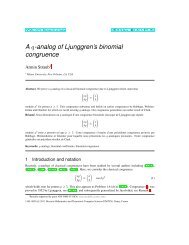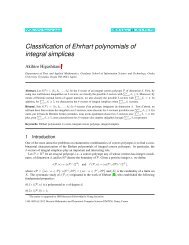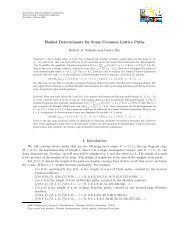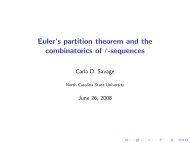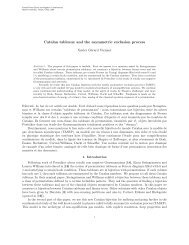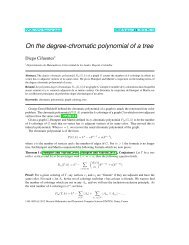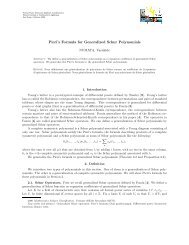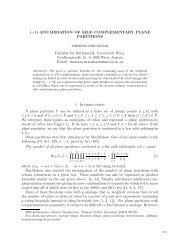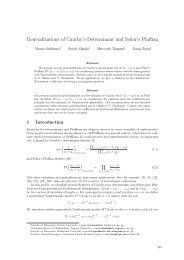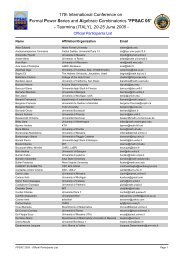Enriched P-partitions and peak algebras of types A ... - garsia at york
Enriched P-partitions and peak algebras of types A ... - garsia at york
Enriched P-partitions and peak algebras of types A ... - garsia at york
Create successful ePaper yourself
Turn your PDF publications into a flip-book with our unique Google optimized e-Paper software.
T. K. Petersento quasisymmetric functions, it does not use enriched P-<strong>partitions</strong> for the study <strong>of</strong> sub<strong>algebras</strong> <strong>of</strong> the groupalgebra Z[S n ] as we will here, <strong>and</strong> the only notion <strong>of</strong> <strong>peak</strong> th<strong>at</strong> it uses is th<strong>at</strong> <strong>of</strong> an interior <strong>peak</strong>. K<strong>at</strong>hrynNyman [20] built on [26] to show th<strong>at</strong> there is a subalgebra <strong>of</strong> the group algebra <strong>of</strong> the symmetric group,akin to Solomon’s descent algebra [25], formed by the linear span <strong>of</strong>v I :=∑π,π∈S nPk(π)=Iwhich we call the interior <strong>peak</strong> algebra, denoted P n . L<strong>at</strong>er, without the use <strong>of</strong> enriched P-<strong>partitions</strong>, MarceloAguiar, Nantel Bergeron, <strong>and</strong> Nyman [1] showed th<strong>at</strong> left <strong>peak</strong>s also give a subalgebra in this sense. We willdenote by P (l)n the linear span <strong>of</strong> sums <strong>of</strong> permut<strong>at</strong>ions with the same set <strong>of</strong> left <strong>peak</strong>s. In [1], the authorsalso examined commut<strong>at</strong>ive sub<strong>algebras</strong> <strong>of</strong> the <strong>peak</strong> <strong>algebras</strong>—the “Eulerian” <strong>peak</strong> <strong>algebras</strong> formed by sums<strong>of</strong> permut<strong>at</strong>ions with the same number <strong>of</strong> <strong>peak</strong>s. One goal <strong>of</strong> this work is to derive some <strong>of</strong> the results <strong>of</strong> [1]as a n<strong>at</strong>ural applic<strong>at</strong>ion <strong>of</strong> enriched P-<strong>partitions</strong>. In doing so, we are led to the type B enriched P-<strong>partitions</strong><strong>and</strong> to the type B <strong>peak</strong> algebra, P B,n .The link between <strong>peak</strong> <strong>algebras</strong> <strong>and</strong> enriched P-<strong>partitions</strong> is through quasisymmetric gener<strong>at</strong>ing functions.Let Qsym := ⊕ n≥0 Qsym n denote the space <strong>of</strong> quasisymmetric functions, where Qsym n denotes thequasisymmetric functions homogeneous <strong>of</strong> degree n. Ira Gessel [16] showed how gener<strong>at</strong>ing functions forordinary P-<strong>partitions</strong> give a n<strong>at</strong>ural basis for Qsym, <strong>and</strong> moreover, he defined a coproduct on Qsym n th<strong>at</strong>makes it the coalgebra dual to Solomon’s descent algebra for the Coxeter group <strong>of</strong> type A n−1 . Stembridge[26] defined gener<strong>at</strong>ing functions for enriched P-<strong>partitions</strong> th<strong>at</strong> form a subring <strong>of</strong> the ring <strong>of</strong> quasisymmetricfunctions, called the <strong>peak</strong> functions. Let Π := ⊕ n≥0 Π n denote the space <strong>of</strong> <strong>peak</strong> functions, with Π n then-th graded component. We will use an approach similar to Gessel’s to give a coproduct on Π n th<strong>at</strong> makesit dual to Nyman’s interior <strong>peak</strong> algebra.Just as Stembridge’s enriched P-<strong>partitions</strong> connect with quasisymmetric functions (the coalgebra dualto Solomon’s type A descent algebra), the new <strong>types</strong> <strong>of</strong> enriched P-<strong>partitions</strong> we present here connect tothe type B quasisymmetric functions, BQsym := ⊕ n≥0 BQsym n (the coalgebra dual to Solomon’s type Bdescent algebra), as defined by Chak-On Chow [13] using type B P-<strong>partitions</strong>. We will define the type B <strong>peak</strong>functions Π B := ⊕ n≥0 Π B,n <strong>and</strong> the left <strong>peak</strong> functions Π (l) := ⊕ n≥0 Π(l) n , <strong>and</strong> give a n<strong>at</strong>ural coproductth<strong>at</strong> makes Π (l)n dual to P (l)n <strong>and</strong> Π B,n dual to P B,n .Remark 1.1. It is known th<strong>at</strong> the quasisymmetric functions form a Hopf algebra, <strong>and</strong> Stembridge’s <strong>peak</strong>functions are a Hopf subalgebra [8]. A n<strong>at</strong>ural question is whether the type B quasisymmetric functionsform a Hopf algebra, <strong>and</strong> they do. As <strong>of</strong> this writing, it is known th<strong>at</strong> the left <strong>peak</strong> functions do not forma Hopf subalgebra, but an unresolved question is whether type B <strong>peak</strong> functions form a Hopf subalgebra.This topic is part <strong>of</strong> ongoing work.2. <strong>Enriched</strong> P-<strong>partitions</strong>The “P” in P-partition st<strong>and</strong>s for a partially ordered set, or poset. For our purposes, we assume th<strong>at</strong> allposets P, with partial order < P , are finite. And unless otherwise noted, if |P | = n, then the elements <strong>of</strong> Pare labeled distinctly with the numbers 1, 2, . . ., n. We will sometimes describe a poset by its Hasse diagram,as in Figure 1. We can think <strong>of</strong> any permut<strong>at</strong>ion π ∈ S n as a poset with the total order π(s) < π π(s + 1).1 2P: L(P):3122133Figure 1. Linear extensions <strong>of</strong> a poset P.
ENRICHED P-PARTITIONS AND PEAK ALGEBRASFor a poset P with n elements, let L(P) denote its Jordan-Hölder set: the set <strong>of</strong> all permut<strong>at</strong>ions <strong>of</strong> [n]which extend P to a total order. This set is also called the set <strong>of</strong> “linear extensions” <strong>of</strong> P. For example letP be the poset defined by 1 > P 3 < P 2. In linearizing P we form a total order by retaining all the rel<strong>at</strong>ions<strong>of</strong> P but introducing new rel<strong>at</strong>ions so th<strong>at</strong> any element is comparable to any other. In this case, 1 <strong>and</strong> 2 arenot comparable, so we have exactly two ways <strong>of</strong> linearizing P: 3 < 2 < 1 or 3 < 1 < 2. These correspond tothe permut<strong>at</strong>ions (3, 2, 1) <strong>and</strong> (3, 1, 2). Let us make the following observ<strong>at</strong>ion.Observ<strong>at</strong>ion 2.1. A permut<strong>at</strong>ion π is in L(P) if <strong>and</strong> only if i < P j implies π −1 (i) < π −1 (j).In other words, if i is “below” j in the Hasse diagram <strong>of</strong> the poset P, it must be below j in any linearextension <strong>of</strong> the poset.We now introduce the basic theory <strong>of</strong> enriched P-<strong>partitions</strong>, building on Stembridge’s work [26]. Tobegin, Stembridge defines P ′ to be the set <strong>of</strong> nonzero integers with the following total order:−1 < 1 < −2 < 2 < −3 < 3 < · · ·We will have use for this set, but we view it as a subset <strong>of</strong> a similar set. Define P (l) to be the integers withthe following total order:0 < −1 < 1 < −2 < 2 < −3 < 3 < · · ·Then P ′ is simply the set <strong>of</strong> all i ∈ P (l) , i > 0. In general, for any countable totally ordered set S = {s 1 , s 2 , . . .}we define S (l) to be the set{s 0 , −s 1 , s 1 , −s 2 , s 2 , . . .},with total orders 0 < −s 1 < s 1 < −s 2 < s 2 < · · ·(so we can think <strong>of</strong> S (l) as two interwoven copies <strong>of</strong> S along with a zero element) <strong>and</strong> define S ′ to be the set{s ∈ S (l) | s > s 0 }. For any s i ∈ {s 0 } ∪ S, we say s i is nonneg<strong>at</strong>ive. On the other h<strong>and</strong>, if i ≠ 0 we say −s iis neg<strong>at</strong>ive. The absolute value removes any minus signs: | ± s| = s for any s ∈ {s 0 } ∪ S.For s <strong>and</strong> t in S (l) , we write s ≤ + t to mean either s < t in S (l) , or s = t ≥ 0. Similarly we define s ≤ − tto mean either s < t in S (l) , or s = t < 0. For example, on P (l) , we have {s | s ≤ + 3} = { 0, ±1, ±2, ±3 },{ s | s ≤ − 3 } = { 0, ±1, ±2, −3 } = { s | s ≤ − −3 }, { s | 0 ≤ + s ≤ + 2 } = { 0, ±1, ±2 } <strong>and</strong> { s | 0 ≤ − s ≤ +2 } = { ±1, ±2 }.Definition 2.2 (<strong>Enriched</strong> P-partition). An enriched P-partition (resp. left enriched P-partition) is anorder-preserving map f : P → S ′ (resp. S (l) ) such th<strong>at</strong> for all i < P j in P,(1) f(i) ≤ + f(j) only if i < j in N,(2) f(i) ≤ − f(j) only if i > j in N.It is helpful to remember th<strong>at</strong> Stembridge’s enriched P-<strong>partitions</strong> are the nonzero left enriched P-<strong>partitions</strong>, i.e., those for which f(i) ≠ s 0 for any i. We let E(P; S) denote the set <strong>of</strong> all enriched P-<strong>partitions</strong>f : P → S ′ ; E (l) (P; S) denotes the set <strong>of</strong> left enriched P-<strong>partitions</strong> f : P → S (l) . If S is irrelevant orunderstood, we simply write E(P) or E (l) (P). For example, if our poset is 1 > P 3 < P 2, thenE (l) (P) = {f : P → S (l) | f(1) ≥ − f(3) ≤ − f(2)},which we can see actually splits into the two following disjoint subsets:{f(3) ≤ − f(1) ≤ + f(2)} ⊔ {f(3) ≤ − f(2) ≤ − f(1)} = E (l) (312) ⊔ E (l) (321).This example leads us to the following, which, by analogy with a similar result for ordinary P-<strong>partitions</strong>,is referred to as the fundamental lemma <strong>of</strong> enriched P-<strong>partitions</strong>. It follows by induction on the number <strong>of</strong>incomparable pairs <strong>of</strong> elements in the poset.Lemma 2.3. For any poset P, the set <strong>of</strong> all (left) enriched P-<strong>partitions</strong> is the disjoint union <strong>of</strong> all (left)enriched π-<strong>partitions</strong> for linear extensions π <strong>of</strong> P. Equivalently,E(P) =∐E(π),E (l) (P) =π∈L(P)∐π∈L(P)E (l) (π).
T. K. PetersenTherefore when studying enriched P-<strong>partitions</strong> it is enough to consider the case where P is a totallyordered chain, i.e., a permut<strong>at</strong>ion π. It is easy to describe the set <strong>of</strong> all enriched π-<strong>partitions</strong> in terms <strong>of</strong>descent sets. For any π ∈ S n we have(2.1)E(π) = { f : [n] → S ′ | f(π(1)) ≤ f(π(2)) ≤ · · · ≤ f(π(n)),i /∈ Des(π) ⇒ f(π(i)) ≤ + f(π(i + 1))i ∈ Des(π) ⇒ f(π(i)) ≤ − f(π(i + 1)) },<strong>and</strong> the analogous description for E (l) (π) where we replace S ′ with S (l) .From (2.1) it is clear th<strong>at</strong> enriched π-<strong>partitions</strong> depend on the descent set <strong>of</strong> π. The connection to <strong>peak</strong>sis less obvious. In section 3 we will establish this link, <strong>and</strong> also show how left enriched π-<strong>partitions</strong> arerel<strong>at</strong>ed to left <strong>peak</strong>s. First, we present our main theorem.Let S <strong>and</strong> T be any two countable totally ordered sets, <strong>and</strong> let S ′ × T ′ = {(s, t) | s ∈ S ′ , t ∈ T ′ } be thecartesian product <strong>of</strong> S ′ <strong>and</strong> T ′ with the up-down order defined as follows: (s, t) < (u, v) if <strong>and</strong> only if(1) s < u, or(2) s = u > 0 <strong>and</strong> t < v, or(3) s = u < 0 <strong>and</strong> t > v.In other words, we read up the nonneg<strong>at</strong>ive columns, down the neg<strong>at</strong>ive ones. Here we write (s, t) ≤ + (u, v)in one <strong>of</strong> three cases: if s < u, or if s = u > 0 <strong>and</strong> t ≤ + v, or if s = u < 0 <strong>and</strong> t ≥ − v. Similarly,(s, t) ≤ − (u, v) if s < u, or if s = u > 0 <strong>and</strong> t ≤ − v, or if s = u < 0 <strong>and</strong> t ≥ + v. We define S (l) × T (l) in thesame way. See Figure 2.Figure 2. The up-down order for P (l) × P (l) .Theorem 2.4. We have the following bijections:(2.2)E(π; S × T) ←→ ∐E(τ; S) × E(σ; T)(2.3)στ=πE (l) (π; S × T) ←→ ∐στ=πE (l) (τ; S) × E(σ; T)Pro<strong>of</strong>. We will provide pro<strong>of</strong> for (2.2) <strong>and</strong> remark th<strong>at</strong> the pro<strong>of</strong> <strong>of</strong> (2.3) is nearly identical.
ENRICHED P-PARTITIONS AND PEAK ALGEBRAS(2.4)For π ∈ S n , we can write the set <strong>of</strong> all enriched π-<strong>partitions</strong> f : π → S ′ × T ′ as follows:E(π) = { F = ((s 1 , t 1 ), . . . , (s n , t n )) ∈ (S ′ × T ′ ) n | (s 1 , t 1 ) ≤ (s 2 , t 2 ) ≤ · · · ≤ (s n , t n ),i /∈ Des(π) ⇒ (s i , t i ) ≤ + (s i+1 , t i+1 )i ∈ Des(π) ⇒ (s i , t i ) ≤ − (s i+1 , t i+1 ) }.We will now sort the points F into distinct cases. For any i = 1, 2, . . ., n − 1, if π(i) < π(i + 1), then(s i , t i ) ≤ + (s i+1 , t i+1 ), which falls into one <strong>of</strong> two mutually exclusive cases:(2.5)(2.6)s i ≤ + s i+1 <strong>and</strong> t i ≤ + t i+1 , ors i ≤ − s i+1 <strong>and</strong> t i ≥ − t i+1 .If π(i) > π(i + 1), then (s i , t i ) ≤ − (s i+1 , t i+1 ), which we split as:(2.7)(2.8)s i ≤ + s i+1 <strong>and</strong> t i ≤ − t i+1 , ors i ≤ − s i+1 <strong>and</strong> t i ≥ + t i+1 ,also mutually exclusive. Define I F to be the set <strong>of</strong> all i such th<strong>at</strong> either (2.6) or (2.8) holds for F. Noticeth<strong>at</strong> in both cases, s i ≤ − s i+1 . Now for any I ⊂ [n − 1], let A I be the set <strong>of</strong> all F s<strong>at</strong>isfying I F = I. Wehave E(π; S × T) = ∐ I⊂[n−1] A I.For any particular I ⊂ [n −1], form the poset P I <strong>of</strong> the elements 1, 2, . . .,n by π(s) < PI π(s+1) if s /∈ I,π(s) > PI π(s + 1) if s ∈ I. We form a “zig-zag” poset (see Figure 3) <strong>of</strong> n elements labeled consecutively byπ(1), π(2), . . . , π(n) with downward zigs corresponding to the elements <strong>of</strong> I.P I :π(2)π(1)π(3)π(5)π(4)Figure 3. The zig-zag poset P I for I = {2, 3} ⊂ [5].For any F in A I , let f : [n] → T ′ be defined by f(π(i)) = t i . It is straightforward to verify th<strong>at</strong> fis an enriched P I -partition. Conversely, any enriched P I -partition f gives a point F in A I since by cases(2.5)–(2.8) above, if t i = f(π(i)), then((s 1 , t 1 ), . . .,(s n , t n )) ∈ A Iif <strong>and</strong> only if s 1 ≤ · · · ≤ s n <strong>and</strong> s i ≤ − s i+1 for all i ∈ I, s i ≤ + s i+1 for i /∈ I. We can therefore turn our<strong>at</strong>tention to enriched P I -<strong>partitions</strong>.Let σ ∈ L(P I ). Recall by Observ<strong>at</strong>ion 2.1 th<strong>at</strong> σ −1 π(i) < σ −1 π(i + 1) if π(i) < PI π(i + 1), i.e., if i /∈ I.If π(i) > PI π(i + 1) then σ −1 π(i) > σ −1 π(i + 1) <strong>and</strong> i ∈ I. We get th<strong>at</strong> Des(σ −1 π) = I if <strong>and</strong> only ifσ ∈ L(P I ). Set τ = σ −1 π. We haveE(τ; S) = {s 1 ≤ · · · ≤ s n | s i ≤ − s i+1 if i ∈ Des(τ), s i ≤ + s i+1 otherwise},<strong>and</strong> since Des(τ) = I, we can write A I as∐{F ∈ (S ′ × T ′ ) n | (s 1 , . . . , s n ) ∈ E(τ; S), (t π −1 σ(1), . . .,t π −1 σ(n)) ∈ E(σ; T)}.σ∈L(P I)στ=πRunning over all subsets I ⊂ [n − 1], we obtainE(π; S × T) = ∐{F ∈ (S ′ × T ′ ) n | (s 1 , . . . , s n ) ∈ E(τ; S), (t π −1 σ(1), . . .,t π −1 σ(n)) ∈ E(σ; T)}.στ=π
T. K. Petersen(Note th<strong>at</strong> π −1 σ = τ −1 .) Now we can see the obvious bijection ∐ στ=πE(τ; S) × E(σ; T) → E(π; S ×T) givenby((s 1 , . . . , s n ), (t 1 , . . . , t n )) ↦→ ((s 1 , t τ(1) ), . . . , (s n , t τ(n) )).Now we present the type B enriched P-<strong>partitions</strong>. When working with signed permut<strong>at</strong>ions, we need tochange our notion <strong>of</strong> a poset slightly. See Chow [13]; this definition is a simpler version <strong>of</strong> the notion due toVic Reiner [23].Definition 2.5. A type B poset, or B n poset, is a poset P whose elements are 0, ±1, ±2, . . ., ±n suchth<strong>at</strong> if i < P j then −j < P −i.Note th<strong>at</strong> if we are given a poset with n + 1 elements labeled by 0, a 1 , . . .,a n where a i = i or −i, thenwe can extend it to a B n poset <strong>of</strong> 2n + 1 elements. For example, the P in Figure 4 could be specified bythe rel<strong>at</strong>ions 0 > P 1 < P −2. In the same way, any signed permut<strong>at</strong>ion π ∈ B n is a B n poset under thetotal order π(s) < π π(s + 1), 0 ≤ s ≤ n − 1. If P is a type B poset, let L B (P) denote the set <strong>of</strong> linearextensions <strong>of</strong> P th<strong>at</strong> are themselves type B posets. Then L B (P) is n<strong>at</strong>urally identified with some set <strong>of</strong>signed permut<strong>at</strong>ions. See Figure 4.□-2-1-1-12-2−1P: L B (P):20−200011-22211Figure 4. A B 2 poset <strong>and</strong> its linear extensions.We will present some altern<strong>at</strong>e not<strong>at</strong>ion for the set S ′ introduced above. Let S = {s 1 , s 2 , . . .} be anycountable totally ordered set. Then we define the set S ′ to be the set{s −11 , s 1, s −12 , s 2, . . .},with total orders1 −1 < s 1 < s −12 < s 2 < · · ·We introduce this new not<strong>at</strong>ion because we want to avoid confusion in defining the setwith the total orderZ ′ = {. . .,−2, −2 −1 , −1, −1 −1 , 0, 1 −1 , 1, 2 −1 , 2, . . .},· · · − 2 < −2 −1 < −1 < −1 −1 < 0 < 1 −1 < 1 < 2 −1 < 2 < · · ·In general, if we define ±S = {. . .,−s 2 , −s 1 , s 0 , s 1 , s 2 , . . .}, we have the total order on ±S ′ given by· · · − s 2 < −s −12 < −s 1 < −s −11 < s 0 < s −11 < s 1 < s −12 < s 2 < · · ·For any s in ±S ′ , let ε(s) be the exponent on s, <strong>and</strong> let |s| be a map ±S ′ → S th<strong>at</strong> forgets signs <strong>and</strong>exponents. For example, if s = −s −1i , then ε(s) = −1 < 0 <strong>and</strong> |s| = s i , while if s = s i , then ε(s) = 1 > 0
ENRICHED P-PARTITIONS AND PEAK ALGEBRAS<strong>and</strong> |s| = s i . For i = 0, we require ε(s 0 ) = 1 > 0, |s 0 | = s 0 , <strong>and</strong> −s 0 = s 0 . Let s ≤ + t mean th<strong>at</strong> s < t in±S ′ or s = t <strong>and</strong> ε(s) > 0. Similarly define s ≤ − t to mean th<strong>at</strong> s < t in ±S ′ or s = t <strong>and</strong> ε(s) < 0.Definition 2.6 (Type B enriched P-partition). For any B n poset P, an enriched P-partition <strong>of</strong> type Bis an order-preserving map f : ±[n] → ±S ′ such th<strong>at</strong> for every i < P j in P,(1) f(i) ≤ + f(j) only if i < j in Z,(2) f(i) ≤ − f(j) only if i > j in Z,(3) f(−i) = −f(i).This definition differs from type A enriched P-<strong>partitions</strong> only in the last condition. It forces f(0) = s 0 ,<strong>and</strong> if we know where to map a 1 , a 2 , . . .,a n , where a i = i or −i, then it tells us where to map everythingelse. Let E B (P; S) denote the set <strong>of</strong> all type B enriched P-<strong>partitions</strong> f : P → ±S ′ . There is a fundamentallemma for type B.Lemma 2.7. We have,E B (P) =∐E B (π).π∈L B(P)We can easily characterize the type B enriched π-<strong>partitions</strong> in terms <strong>of</strong> descent sets, keeping in mindth<strong>at</strong> if we know where to map i, then we know where to map −i by the symmetry property: f(−i) = −f(i).For any signed permut<strong>at</strong>ion π ∈ B n we have(2.9)E B (π) = { f : [n] → ±S ′ | s 0 ≤ f(π(1)) ≤ f(π(2)) ≤ · · · ≤ f(π(n))i /∈ Des B (π) ⇒ f(π(i)) ≤ + f(π(i + 1)),i ∈ Des B (π) ⇒ f(π(i)) ≤ − f(π(i + 1)) }.Notice th<strong>at</strong> since ε(s 0 ) = 1, then s 0 ≤ − f(π(1)) is the same as saying s 0 < f(π(1)), <strong>and</strong> s 0 ≤ + f(π(1)) isthe same as s 0 ≤ f(π(1)). We will show th<strong>at</strong> the set <strong>of</strong> type B enriched P-<strong>partitions</strong> rel<strong>at</strong>es to the set <strong>of</strong>type B <strong>peak</strong>s. First, we present the main theorem for type B enriched P-<strong>partitions</strong>. Its pro<strong>of</strong> varies onlyslightly from th<strong>at</strong> <strong>of</strong> Theorem 2.4 <strong>and</strong> is omitted. Let E B (P; S ×T) denote the set <strong>of</strong> all enriched P-<strong>partitions</strong>f : P → ±S ′ × ±T ′ with the up-down order.Theorem 2.8. We have the following bijection:(2.10) E B (π; S × T) ←→ ∐στ=πE B (τ; S) × E B (σ; T)3. Gener<strong>at</strong>ing functionsRecall th<strong>at</strong> a quasisymmetric function is a formal seriesQ(x 1 , x 2 , . . .) ∈ Z[[x 1 , x 2 , . . .]]<strong>of</strong> bounded degree such th<strong>at</strong> for any composition α = (α 1 , α 2 , . . .,α k ), the coefficient <strong>of</strong> x α11 xα2 2 · · · xα kkis thesame as the coefficient <strong>of</strong> x α1i 1x α2i 2 · · ·x α ki kfor all i 1 < i 2 < · · · < i k . Recall th<strong>at</strong> a composition <strong>of</strong> n, writtenα |= n, is an ordered tuple <strong>of</strong> positive integers α = (α 1 , α 2 , . . .,α k ) such th<strong>at</strong> |α| = α 1 + α 2 + · · · + α k = n.In this case we say th<strong>at</strong> α has k parts, or l(α) = k. We can put a partial order on the set <strong>of</strong> all compositions<strong>of</strong> n by refinement. The covering rel<strong>at</strong>ions are <strong>of</strong> the form(α 1 , . . . , α i + α i+1 , . . .,α k ) ≺ (α 1 , . . .,α i , α i+1 , . . .,α k ).⊕Let Qsym n denote the set <strong>of</strong> all quasisymmetric functions homogeneous <strong>of</strong> degree n. Then Qsym :=n≥0 Qsym n denotes the graded ring <strong>of</strong> all quasisymmetric functions, where Qsym 0 = Z.The most obvious basis for Qsym n is the set <strong>of</strong> monomial quasisymmetric functions, defined for anycomposition α = (α 1 , α 2 , . . . , α k ) |= n,∑M α := x α1i 1x α2i 2 · · ·x α ki k.i 1
T. K. PetersenThere are 2 n−1 compositions <strong>of</strong> n, <strong>and</strong> hence, the graded component Qsym n has dimension 2 n−1 as a vectorspace. We can form another n<strong>at</strong>ural basis with the fundamental quasisymmetric functions, also indexed bycompositions,F α := ∑ α≤βM β ,since, by inclusion-exclusion we can express the M α in terms <strong>of</strong> the F α :M α = ∑ α≤β(−1) l(β)−l(α) F β .There is a well-known bijection between compositions <strong>of</strong> n <strong>and</strong> subsets <strong>of</strong> [n − 1] given byα ↦→ I(α) = {α 1 , α 1 + α 2 , . . .,α 1 + · · · + α k−1 },<strong>and</strong> so we can also write M α = M I(α) or F α = F I(α) when convenient.Define the gener<strong>at</strong>ing function for enriched P-<strong>partitions</strong> f : P → P ′ byΛ(P) = ∑ n∏z |f(i)| .f∈E(P) i=1Then clearly Λ(P) is a quasisymmetric function. By the fundamental Lemma 2.3, we have th<strong>at</strong>Λ(P) = ∑Λ(π).π∈L(P)For any subset <strong>of</strong> the integers I, define the set I + 1 = {i + 1 | i ∈ I}. From [26] we see th<strong>at</strong> thegener<strong>at</strong>ing function for enriched π-<strong>partitions</strong> depends only on the <strong>peak</strong> set <strong>of</strong> π.Theorem 3.1 (Stembridge [26], Proposition 2.2). For π ∈ S n , we have the following equality:∑Λ(π) = 2 |E|+1 M E .E⊂[n−1]Pk(π)⊂E∪(E+1)For any sets I <strong>and</strong> J, let I △ J = (I ∪J)\(I ∩J) denote the symmetric difference <strong>of</strong> sets. The gener<strong>at</strong>ingfunctions are also F-positive.Theorem 3.2 (Stembridge [26], Proposition 3.5). For π ∈ S n , we have the following equality:∑(3.1) Λ(π) = 2 | Pk(π)|+1 F D .D⊂[n−1]Pk(π)⊂D△(D+1)For interior <strong>peak</strong> sets I, let K I be the quasisymmetric function defined byK I := Λ(π),where π is any permut<strong>at</strong>ion such th<strong>at</strong> Pk(π) = I. Let Π n denote the space <strong>of</strong> quasisymmetric functionsspanned by the K I , where I runs over all interior <strong>peak</strong> sets <strong>of</strong> [n − 1]. Stembridge then defines the set <strong>of</strong><strong>peak</strong> functions Π := ⊕ n≥0 Π n, which is a graded subring <strong>of</strong> Qsym. He proved th<strong>at</strong> the functions K I arelinearly independent, <strong>and</strong> so the rank <strong>of</strong> Π n is the the number <strong>of</strong> distinct interior <strong>peak</strong> sets, which happensto be the Fibonacci number f n−1 , defined by f 0 = f 1 = 1 <strong>and</strong> f n = f n−1 + f n−2 for n ≥ 2.Before discussing gener<strong>at</strong>ing functions for left enriched P-<strong>partitions</strong> <strong>and</strong> type B enriched P-<strong>partitions</strong>,we need to introduce Chow’s type B quasisymmetric functions [13]. Define a pseudo-composition <strong>of</strong> n,written α ⊩ n, to be an ordered tuple <strong>of</strong> nonneg<strong>at</strong>ive integers (α 1 , α 2 , . . . , α k ) whose sum |α| = α 1 + · · ·+α kis n, where α 1 ≥ 0, α i > 0 for i > 1. In other words, given any ordinary composition α |= n, we havetwo corresponding pseudo-compositions: α <strong>and</strong> 0α = (0, α 1 , . . . , α k ). The partial order on the set <strong>of</strong> allpseudo-compositions <strong>of</strong> n is again by refinement.Now we can define a type B quasisymmetric function to be a formal seriesQ(x 0 , x 1 , x 2 , . . .) ∈ Z[[x 0 , x 1 , x 2 , . . .]]<strong>of</strong> bounded degree such th<strong>at</strong> for any pseudo-composition α = (α 1 , α 2 , . . .,α k ), the coefficient <strong>of</strong> x α10 xα2 1 · · · xα kk−1is the same as the coefficient <strong>of</strong> x α10 xα2 i 2 · · · x α ki kfor all 0 < i 2 < · · · < i k . Let BQsym n denote the set <strong>of</strong> allquasisymmetric functions homogeneous <strong>of</strong> degree n. Then BQsym := ⊕ n≥0 BQsym n is the ring <strong>of</strong> type
ENRICHED P-PARTITIONS AND PEAK ALGEBRASB quasisymmetric functions. As before we have a monomial <strong>and</strong> fundamental basis for BQsym n . For anypseudo-composition α = (α 1 , α 2 , . . . , α k ) ⊩ n, the monomial functions areM B,α :=∑x α10 xα2 i 2 · · · x α ki k.i 2
T. K. PetersenWe define the functions K B,I byK B,I := Λ B (π),where π is any permut<strong>at</strong>ion such th<strong>at</strong> Pk B (π) = I. Note th<strong>at</strong> for a permut<strong>at</strong>ion π ∈ S n , if Λ (l) (π) = K B,Ithen 0 /∈ I.Let Π B,n denote the span <strong>of</strong> the K B,I , where I ranges over all type B <strong>peak</strong> sets <strong>of</strong> [0, n − 1]. It is nothard to see th<strong>at</strong> the K B,I are linearly independent, <strong>and</strong> so by counting the number <strong>of</strong> type B <strong>peak</strong> sets wesee Π B,n has rank f n+1 . If we define the type B <strong>peak</strong> functions, Π B := ⊕ n≥0 Π B,n, then we can see it is asubring <strong>of</strong> BQsym, as an argument identical to th<strong>at</strong> <strong>of</strong> [26] Theorem 3.1 shows.Π (l)nSimilarly, let Π (l)ndenote the span <strong>of</strong> all K B,I , where I ranges over the left <strong>peak</strong> sets in [1, n − 1]. Thenhas rank f n <strong>and</strong> the left <strong>peak</strong> functions, Π (l) := ⊕ n≥0 Π(l) n , form a subring <strong>of</strong> Π B .4. DualityLet X = {x 1 , x 2 , . . .} <strong>and</strong> Y = {y 1 , y 2 , . . .} be two sets <strong>of</strong> commuting indetermin<strong>at</strong>es. Define the setXY = {xy : x ∈ X, y ∈ Y }. Then we define the bipartite gener<strong>at</strong>ing function,∑Λ(P)(XY ) = x s1 · · · x sn y t1 · · · y tn .F ∈E(P;P×P)The functions Λ (l) (P)(XY ) <strong>and</strong> Λ B (P)(XY ) are defined similarly. Then the following are consequences <strong>of</strong>Theorem 2.4 <strong>and</strong> Theorem 2.8.Theorem 4.1. For any π ∈ S n , we have the following equ<strong>at</strong>ions:(4.1)Λ(π)(XY ) = ∑Λ(τ)(X)Λ(σ)(Y ),(4.2)στ=πΛ (l) (π)(XY ) = ∑στ=πΛ (l) (τ)(X)Λ (l) (σ)(Y ).Theorem 4.2. For any π ∈ B n , we have the following equ<strong>at</strong>ion:(4.3) Λ B (π)(XY ) = ∑Λ B (τ)(X)Λ B (σ)(Y ).στ=πThe formulas above imply duality between Π n <strong>and</strong> P n , Π (l)n<strong>and</strong> P (l)n , <strong>and</strong> Π B,n <strong>and</strong> P B,n . Moreover,they give an explicit combin<strong>at</strong>orial description for the structure constants <strong>of</strong> the <strong>algebras</strong>. We will show howthis works for the case <strong>of</strong> interior <strong>peak</strong>s. The steps <strong>of</strong> the construction are the same for the other cases.First, notice th<strong>at</strong> equ<strong>at</strong>ion (4.1) implies th<strong>at</strong>K C (XY ) = ∑ A,Bc C A,BK A (X)K B (Y ),where the sum is over all pairs <strong>of</strong> interior <strong>peak</strong> subsets A <strong>and</strong> B <strong>of</strong> [2, n − 1], <strong>and</strong> if π ∈ S n is anypermut<strong>at</strong>ion with Pk(π) = C, then the integer c C A,B is the number <strong>of</strong> pairs <strong>of</strong> permut<strong>at</strong>ions σ, τ such th<strong>at</strong>Pk(σ) = B, Pk(τ) = A, <strong>and</strong> στ = π. We now use this formula to define Π n as a coalgebra with coproduct∆ : Π n → Π n ⊗ Π n defined as∆(K C ) = ∑ c C A,B K A ⊗ K B .A,BWe can define a coalgebra Z[S n ] ∗ dual to the group algebra with coproduct defined as∆(π) = ∑τ ⊗ σ.στ=πDefine the map ϕ ∗ : Z[S n ] ∗ → Π n by ϕ ∗ (π) = K Pk(π) , which, by (4.1), is a surjective homomorphism <strong>of</strong>co<strong>algebras</strong>. Now we dualize.Let Π ∗ n be the algebra dual to Π n, with basis elements KI ∗ . By definition, multiplic<strong>at</strong>ion in this basis isK ∗ AK ∗ B = ∑ Cc C A,BK ∗ C,
ENRICHED P-PARTITIONS AND PEAK ALGEBRASwhere the sum is over all interior <strong>peak</strong> subsets C. The dual <strong>of</strong> ϕ ∗ is now an injective homomorphism <strong>of</strong><strong>algebras</strong>, ϕ : Π ∗ n → Z[S n ] defined byϕ(KI ∗ ) =∑π = v I .Pk(π)=IThus the interior <strong>peak</strong> algebra can be defined as the image <strong>of</strong> ϕ, <strong>and</strong> the structure constants carry through:v A v B = ∑ Cc C A,Bv C .We describe the structure constants for the left <strong>and</strong> type B <strong>peak</strong> <strong>algebras</strong>:• Let d C A,B , over triples <strong>of</strong> left <strong>peak</strong> sets A, B, C, be the structure constants for P(l) n . Then for anyπ ∈ S n such th<strong>at</strong> Pk (l) (π) = C, the integer d C A,B is the number <strong>of</strong> pairs <strong>of</strong> permut<strong>at</strong>ions σ, τ suchth<strong>at</strong> Pk (l) (σ) = B, Pk (l) (τ) = A, <strong>and</strong> στ = π.• Let e C A,B , over triples <strong>of</strong> type B <strong>peak</strong> sets A, B, C, be the structure constants for P B,n. Then forany π ∈ B n such th<strong>at</strong> Pk B (π) = C, the integer e C A,B is the number <strong>of</strong> pairs <strong>of</strong> permut<strong>at</strong>ions σ, τsuch th<strong>at</strong> Pk B (σ) = B, Pk B (τ) = A, <strong>and</strong> στ = π.The type B <strong>peak</strong> algebra is something new, defined as the linear span <strong>of</strong> sums <strong>of</strong> signed permut<strong>at</strong>ionsin B n with common type B <strong>peak</strong> set.Theorem 4.3. The space P B,n is a subalgebra <strong>of</strong> Z[B n ] <strong>of</strong> dimension f n+1 . (In fact it is a subalgebra<strong>of</strong> Solomon’s descent algebra for type B n .)Remark 4.4. While P (l)n was introduced in [1], the authors had no combin<strong>at</strong>orial description for itsstructure constants (see [1], Remark 4.4), <strong>and</strong> neither were the structure constants for P n known. Independently,Nantel Bergeron <strong>and</strong> Christophe Hohlweg [7] recently gave the same description we give here.Remark 4.5. Theorem 2.4 can be modified to combine left enriched P-<strong>partitions</strong> <strong>and</strong> interior enrichedP-<strong>partitions</strong>. When transl<strong>at</strong>ed to gener<strong>at</strong>ing functions, it implies th<strong>at</strong> Π n is a two-sided ideal in Π (l)n , <strong>and</strong>hence P n is an ideal in P (l)n .5. Specializ<strong>at</strong>ionsDefine the polynomial Ω(P; x), called the enriched order polynomial, over all positive integers k byΩ(P; k) := Λ(P)(1, 1, . . .,1, 0, 0, . . .),} {{ }kmeaning we set z i = 1 for i = 1, . . .,k, <strong>and</strong> z i = 0 for i > k. It turns out th<strong>at</strong> for π ∈ S n , Ω(π; x) is an evenor odd polynomial <strong>of</strong> degree n th<strong>at</strong> only depends on the number <strong>of</strong> interior <strong>peak</strong>s <strong>of</strong> π (see [22], Proposition4.4). We can use order polynomials to study commut<strong>at</strong>ive <strong>peak</strong> <strong>algebras</strong>, spanned by sums <strong>of</strong> permut<strong>at</strong>ionswith the same number <strong>of</strong> <strong>peak</strong>s. We sketch the idea for the interior <strong>peak</strong>s case.Let E i be the sum <strong>of</strong> all permut<strong>at</strong>ions with i interior <strong>peak</strong>s, <strong>and</strong> let Ω(i; x) denote the order polynomialfor any such permut<strong>at</strong>ion. Now we define:⎧n/2∑(5.1) ρ(x) := ∑π∈S nΩ(π; x/2)π =⌊ n+12 ⌋∑i=1⎪⎨Ω(i; x/2)E i =⎪⎩e i x 2ii=1(n+1)/2∑i=1e i x 2i−1if n is even,if n is odd.The function ρ(x) is a polynomial in x with coefficients in the group algebra Q[S n ] (we now need to workover the r<strong>at</strong>ional numbers). From Theorem 2.4 we can obtain the following.Theorem 5.1. As polynomials in x <strong>and</strong> y with coefficients in the group algebra Q[S n ], we have:ρ(x)ρ(y) = ρ(xy).
T. K. Petersen(δ ij e ∗ i e∗ j ) e j e j e (l)je i e i e i e i e ie (r)je i e i e i e i e ie (l)i e i e i e (l)ie (r)i e i e i e (r)ie (r)ie (l)iTable 1. Multiplic<strong>at</strong>ion table for type A coefficients.Wh<strong>at</strong> the theorem tells us is th<strong>at</strong> the coefficients e i as defined by (5.1) are mutually orthogonal idempotents.With a little more work, we see th<strong>at</strong> the span <strong>of</strong> the E i is the same as the span <strong>of</strong> the e i , so th<strong>at</strong>the sums <strong>of</strong> permut<strong>at</strong>ions with common <strong>peak</strong> numbers span a commut<strong>at</strong>ive ⌊ n+12⌋-dimensional subalgebra<strong>of</strong> the group algebra. This algebra <strong>and</strong> its left <strong>peak</strong> variant were introduced in [1].We can use the same approach to get similar results for other commut<strong>at</strong>ive <strong>peak</strong> <strong>algebras</strong>, given by thespan <strong>of</strong> sums <strong>of</strong> permut<strong>at</strong>ions with the same number <strong>of</strong> right <strong>peak</strong>s, exterior <strong>peak</strong>s, <strong>and</strong> type B <strong>peak</strong>s. Table1 summarizes how the different type A <strong>peak</strong> idempotents interact (though e (r)i is not technically idempotent).We remark th<strong>at</strong> while the number <strong>of</strong> right <strong>peak</strong>s does not give a basis on its own, its multiplic<strong>at</strong>ive closureis still a proper subalgebra.6. Neg<strong>at</strong>ive resultsBefore anything was proved, the type B <strong>peak</strong> algebra was found experimentally, <strong>and</strong> along the road to itsdiscovery there were several dead-end definitions. To save others the trouble <strong>of</strong> these detours, we finish witha list <strong>of</strong> some sub<strong>algebras</strong> th<strong>at</strong> do not exist in general. For the symmetric group, the sums <strong>of</strong> permut<strong>at</strong>ionswith the same set <strong>of</strong> right <strong>peak</strong>s do not form an algebra, nor do the sums <strong>of</strong> permut<strong>at</strong>ions with the same set<strong>of</strong> exterior <strong>peak</strong>s. For the hyperoctahedral group, we do not get a proper subalgebra by taking the sums <strong>of</strong>permut<strong>at</strong>ions with the same: interior <strong>peak</strong> set (i.e., ignoring <strong>peak</strong>s <strong>at</strong> 0), number <strong>of</strong> interior <strong>peak</strong>s, exterior<strong>peak</strong> set, or exterior <strong>peak</strong> number.References[1] M. Aguiar, N. Bergeron, <strong>and</strong> K. Nyman, The <strong>peak</strong> algebra <strong>and</strong> the descent <strong>algebras</strong> <strong>of</strong> <strong>types</strong> B <strong>and</strong> D, Transactions <strong>of</strong> theAmerican M<strong>at</strong>hem<strong>at</strong>ical Society 356 (2004), 2781–2824.[2] M. Aguiar, K. Nyman, <strong>and</strong> R. Orellana, New results on the <strong>peak</strong> algebra, m<strong>at</strong>h.CO/0406418.[3] F. Bergeron <strong>and</strong> N. Bergeron, A decomposition <strong>of</strong> the descent algebra <strong>of</strong> the hyperoctahedral group. I. Journal <strong>of</strong> Algebra148 (1992), 86–97.[4] F. Bergeron <strong>and</strong> N. Bergeron, Orthogonal idempotents in the descent algebra <strong>of</strong> B n <strong>and</strong> applic<strong>at</strong>ions, Journal <strong>of</strong> Pure <strong>and</strong>Applied Algebra 79 (1992), 109–129.[5] N. Bergeron, A decomposition <strong>of</strong> the descent algebra <strong>of</strong> the hyperoctahedral group. II. Journal <strong>of</strong> Algebra 148 (1992),98–122.[6] N. Bergeron, F. Hivert, <strong>and</strong> J.-Y. Thibon, The <strong>peak</strong> algebra <strong>and</strong> the Hecke-Clifford <strong>algebras</strong> <strong>at</strong> q=0, m<strong>at</strong>h.CO/0304191.[7] N. Bergeron <strong>and</strong> C. Hohlweg, Coloured <strong>peak</strong> <strong>algebras</strong> <strong>and</strong> Hopf <strong>algebras</strong>, m<strong>at</strong>h.AC/0505612.[8] N. Bergeron, S. Mykytiuk, F. Sottile, <strong>and</strong> S. van Willigenburg, Shifted quasi-symmetric functions <strong>and</strong> the Hopf algebra <strong>of</strong><strong>peak</strong> functions, Discrete M<strong>at</strong>hem<strong>at</strong>ics 256 (2002), 57–66.[9] L. Billera, S. Hsiao, <strong>and</strong> S. van Willigenburg, Peak quasisymmetric functions <strong>and</strong> Eulerian enumer<strong>at</strong>ion, Advances inM<strong>at</strong>hem<strong>at</strong>ics 176 (2003), 248–276.[10] P. Cellini, A general commut<strong>at</strong>ive descent algebra, Journal <strong>of</strong> Algebra 175 (1995), 990–1014.[11] P. Cellini, A general commut<strong>at</strong>ive descent algebra. II. The case C n, Journal <strong>of</strong> Algebra 175 (1995), 1015–1026.[12] P. Cellini, Cyclic Eulerian elements, European Journal <strong>of</strong> Combin<strong>at</strong>orics 19 (1998), 545–552.[13] C.-O. Chow, Noncommut<strong>at</strong>ive symmetric functions <strong>of</strong> type B, Ph.D. thesis (2001).[14] J. Fulman, Affine shuffles, shuffles with cuts, the Whitehouse model, <strong>and</strong> p<strong>at</strong>ience sorting, Journal <strong>of</strong> Algebra 231 (2000),614–639.[15] A. Garsia <strong>and</strong> C. Reutenauer, A decomposition <strong>of</strong> Solomon’s descent algebra, Advances in M<strong>at</strong>hem<strong>at</strong>ics 77 (1989), 189–262.[16] I. Gessel, Multipartite P-<strong>partitions</strong> <strong>and</strong> inner products <strong>of</strong> skew Schur functions, Contemporary M<strong>at</strong>hem<strong>at</strong>ics 34 (1984),289–317.[17] D. Krob, J.-Y. Thibon Higher order <strong>peak</strong> <strong>algebras</strong>, m<strong>at</strong>h.CO/0411407.[18] J.-L. Loday, Opeér<strong>at</strong>ions sur l’homologie cyclique des algèbres commut<strong>at</strong>ives, Inventiones m<strong>at</strong>hem<strong>at</strong>icae 96 (1989), 205–230.[19] S. Mahajan, Shuffles on Coxeter groups, m<strong>at</strong>h.CO/0108094.
ENRICHED P-PARTITIONS AND PEAK ALGEBRAS[20] K. Nyman, The <strong>peak</strong> algebra <strong>of</strong> the symmetric group, Journal <strong>of</strong> Algebraic Combin<strong>at</strong>orics 17 (2003), 309–322.[21] T. K. Petersen, Cyclic descents <strong>and</strong> P-<strong>partitions</strong>, Journal <strong>of</strong> Algebraic Combin<strong>at</strong>orics 22 (2005), 343–375.[22] T. K. Petersen, <strong>Enriched</strong> P-<strong>partitions</strong> <strong>and</strong> <strong>peak</strong> <strong>algebras</strong>, Advances in M<strong>at</strong>hem<strong>at</strong>ics, to appear.[23] V. Reiner, Signed posets, Journal <strong>of</strong> Combin<strong>at</strong>orial Theory Series A 62 (1993), 324–360.[24] M. Schocker, The <strong>peak</strong> algebra <strong>of</strong> the symmetric group revisited, Advances in M<strong>at</strong>hem<strong>at</strong>ics 192 (2005), 259–309.[25] L. Solomon, A Mackey formula in the group ring <strong>of</strong> a finite Coxeter group, Journal <strong>of</strong> Algebra 41 (1976), 255–264.[26] J. Stembridge, <strong>Enriched</strong> P-<strong>partitions</strong>, Transactions <strong>of</strong> the American M<strong>at</strong>hem<strong>at</strong>ical Society 349 (1997), 763–788.Department <strong>of</strong> M<strong>at</strong>hem<strong>at</strong>ics, Br<strong>and</strong>eis University, Waltham, MA, USA, 02454E-mail address: tkpeters@br<strong>and</strong>eis.eduURL: http://people.br<strong>and</strong>eis.edu/~tkpeters



